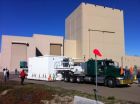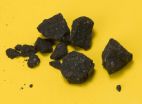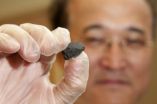(Press-News.org) An oversized semi-trailer truck carrying NASA's Landsat Data Continuity Mission (LDCM) has arrived at its launch site at Vandenberg Air Force Base in California in preparation for launch. This NASA and U.S. Geological Survey mission will continue a 40-year record of measuring change on the planet from space.
LDCM is the eighth satellite in the Landsat series, which began in 1972. It will extend and expand global land observations that are critical in many sectors, including energy and water management, forest monitoring, human and environmental health, urban planning, disaster recovery and agriculture.
Following final tests, the LDCM satellite will be attached to an Atlas V rocket and launched into space February 11, 2013. Built and tested by Orbital Science Corp., LDCM left their Gilbert, Ariz. facility on Dec. 17.
"LDCM builds on and strengthens a key American resource: a decades-long, unbroken Landsat-gathered record of our planet's natural resources, particularly its food, water and forests," said Jim Irons, Landsat project scientist at NASA's Goddard Space Flight Center in Greenbelt, Md.
LDCM carries two instruments, the Operational Land Imager (OLI) built by Ball Aerospace & Technologies Corp. in Boulder, Colo., and the Thermal Infrared Sensor (TIRS) built by NASA Goddard "Both of these instruments have evolutionary advances that make them the most advanced Landsat instruments to date and are designed to improve performance and reliability to improve observations of the global land surface," said Ken Schwer, LDCM project manager at NASA Goddard.
OLI will continue observations in the visible, near infrared, and shortwave infrared portions of the electromagnetic spectrum and includes two new spectral bands, one of which is designed to support monitoring of coastal waters and the other to detect previously hard to see cirrus clouds that can otherwise unknowingly impact the signal from the Earth surface in the other spectral bands. TIRS will collect data in two thermal bands and will thus be able to measure the temperature of the Earth's surface, a measurement that's vital to monitoring water consumption, especially in the arid western United States.
NASA and the U.S. Department of the Interior through the U.S. Geological Survey (USGS) jointly manage the Landsat program. After launch and the initial check out phase, USGS will take operational control of the satellite, will collect, archive, and distribute the data from OLI and TIRS, and will rename the satellite as Landsat 8. The LDCM data will be freely and openly available through the USGS data system.
NASA's Launch Services Program at Kennedy is responsible for launch management. United Launch Alliance is the provider of the Atlas V launch service.
INFORMATION:
For more information, please visit: http://www.nasa.gov/Landsat
Eighth Landsat satellite arrives at launch site
2012-12-21
ELSE PRESS RELEASES FROM THIS DATE:
Protein kinase Akt identified as arbiter of cancer stem cell fate
2012-12-21
PHILADELPHIA — The protein kinase Akt is a key regulator of cell growth, proliferation, metabolism, survival, and death. New work on Akt's role in cancer stem cell biology from the lab of senior author Honglin Zhou, MD, PhD and Weihua Li, co-first author, both from the Center for Resuscitation Sciences, Department of Emergency Medicine, Perelman School of Medicine, University of Pennsylvania, and Xiaowei Xu, Department of Pathology and Laboratory Medicine, appears in Molecular Cell. The findings were also highlighted in Nature and Science reviews.
This new research shows ...
Discovery of Africa moth species important for agriculture, controlling invasive plants
2012-12-21
GAINESVILLE, Fla. — In the rain forests of the Congo, where mammals and birds are hunted to near-extinction, an impenetrable sound of buzzing insects blankets the atmosphere.
Because it is a fairly inaccessible region with political unrest, much of the Congo's insect biodiversity remains largely undiscovered. In a new monographic book published this week in Zootaxa, researchers at the University of Florida and the Royal Museum of Central Africa in Belgium provide insect biodiversity information for this area in Central Africa that increasingly undergoes habitat destruction. ...
U of T Researchers uncover major source of evolutionary differences among species
2012-12-21
University of Toronto Faculty of Medicine researchers have uncovered a genetic basis for fundamental differences between humans and other vertebrates that could also help explain why humans are susceptible to diseases not found in other species.
Scientists have wondered why vertebrate species, which look and behave very differently from one another, nevertheless share very similar repertoires of genes. For example, despite obvious physical differences, humans and chimpanzees share a nearly identical set of genes.
The team sequenced and compared the composition of hundreds ...
New meteorite suggests that asteroid surfaces more complex than previously thought
2012-12-21
Meteorites that had fallen from an asteroid impact that lit up the skies over California and Nevada in April are showing scientists just how complex an asteroid surface can be. A new study published in Science this week by an international team of researchers describes the speedy recovery of the meteorites and reports that this space rock is an unusual example from a rare group known as carbonaceous chondrites, which contain some of the oldest material in the solar system. The study of these meteorites and others like them could hold answers to unsolved mysteries about ...
Gift misgivings? Trust your gut
2012-12-21
CHESTNUT HILL, MA (Dec. 20, 2012) – The clock is ticking and you still haven't decided what to get that special someone in your life for the holidays. When it comes to those last-minute gift-buying decisions for family and close friends, intuition may be the best way to think your way through to that perfect gift.
When faced with tough decisions, some people like to "trust their gut" and go with their intuition. Others prefer to take an analytical approach.
Boston College Professor Michael G. Pratt, an expert in organizational psychology, says new research shows intuition ...
Meteorite triggered scientific gold rush
2012-12-21
A meteorite that exploded as a fireball over California's Sierra foothills this past spring was among the fastest, rarest meteorites known to have hit the Earth, and it traveled a highly eccentric orbital route to get here.
An international team of scientists presents these and other findings in a study published Friday, Dec. 21, in the journal Science. The 70-member team included nine researchers from UC Davis, along with scientists from the SETI Institute, NASA and other institutions.
The researchers found that the meteorite that fell over Northern California on April ...
Engineers seek ways to convert methane into useful chemicals
2012-12-21
Little more than a decade ago, the United States imported much of its natural gas. Today, the nation is tapping into its own natural gas reserves and producing enough to support most of its current needs for heating and power generation, and is beginning to export natural gas to other countries.
The trend is expected to continue, as new methods are developed to extract natural gas from vast unrecovered reserves embedded in shale. Natural gas can be used to generate electricity, and it burns cleaner than coal.
"With petroleum reserves in decline, natural gas production ...
Clays on Mars: More plentiful than expected
2012-12-21
A new study co-authored by the Georgia Institute of Technology indicates that clay minerals, rocks that usually form when water is present for long periods of time, cover a larger portion of Mars than previously thought. In fact, Assistant Professor James Wray and the research team say clays were in some of the rocks studied by Opportunity when it landed at Eagle crater in 2004. The rover only detected acidic sulfates and has since driven about 22 miles to Endeavour Crater, an area of the planet Wray pinpointed for clays in 2009.
The study is published online in the ...
Lifestyle changes linked to better outcomes after peripheral intervention
2012-12-21
ANN ARBOR, Mich. – Patients who quit smoking and took an aspirin and statin before undergoing treatment for blocked leg arteries were less likely to suffer a complication six months later, according to new research led by the University of Michigan Cardiovascular Center.
But few patients made the lifestyle changes and were on recommended medical therapy that can relieve leg pain and cramping associated with peripheral arterial disease, or PAD.
The registry findings were published online ahead of print in Circulation: Cardiovascular Interventions and reveal a dramatic ...
Study shows heart calcium scan predictive of diabetes-related death from cardiovascular disease
2012-12-21
WINSTON-SALEM, N.C. – Dec. 20, 2012 – People with Type 2 diabetes have two to four times the risk of cardiovascular disease compared to people without the disease. The best way for doctors to predict which diabetes patients are at the greatest risk for heart disease is to use a coronary artery calcium (CAC) test in addition to the most commonly used assessment tool, according to researchers at Wake Forest Baptist Medical Center.
Current medical guidelines recommend treating all diabetes patients as high risk, but the Wake Forest Baptist study found that CAC can identify ...


